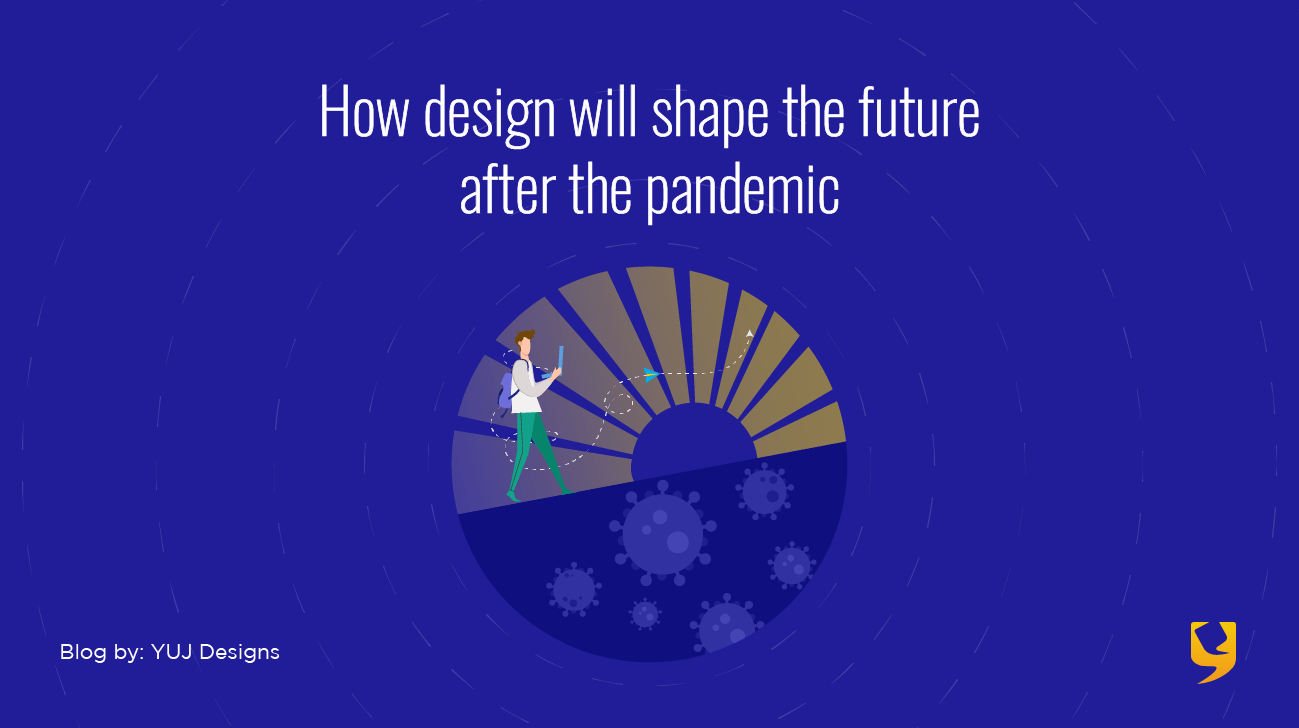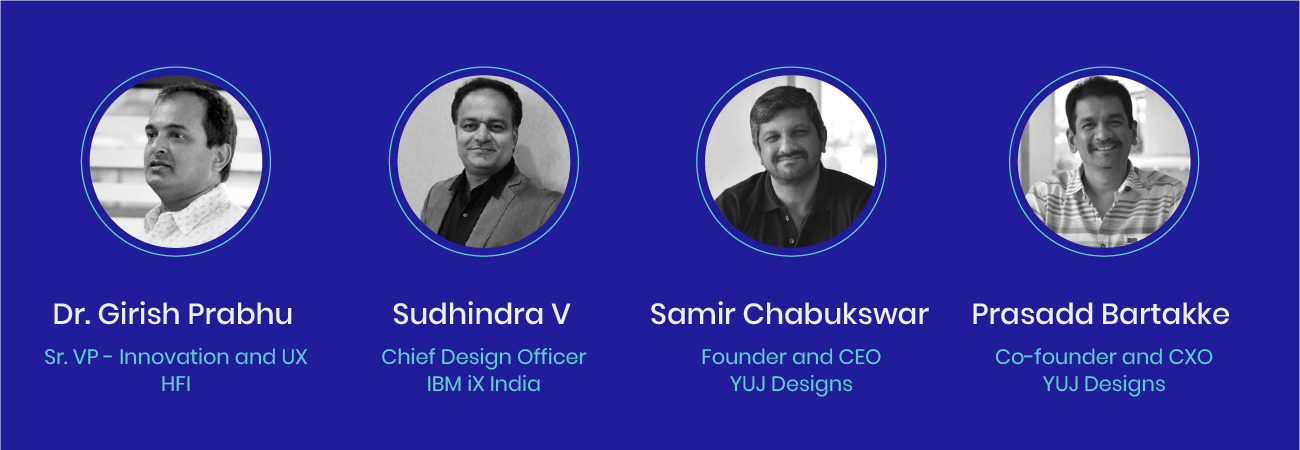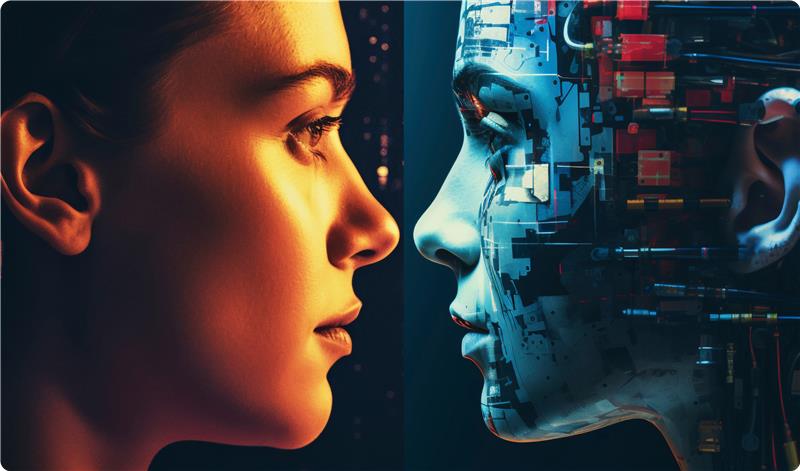
Together, we’re approaching uncharted territories as each and every individual is feeling the impact globally. During a pandemic, of course, there will be major shifts witnessed. In the way people think, feel, and act. What’s critical for businesses is understanding these shifts and effects on all layers to better manage their responses going forward.
At YUJ Designs, we are opening up yet another conversation with our design community. YUJ hosted the very first webinar on – Impact of Design in a post-pandemic world with great success. This article summaries the conversations that happened, key factors we discussed, and the knowledge that was shared throughout the webinar. This webinar brought together some of the experts and industry stalwarts as our panelists for the day.

Prasadd: What’s the nature of impact of the pandemic on design and technology in your view?
Girish: A recent McKinsey report says consumers’ optimism across the board is going down. Their rate of spending is going down. This has a direct impact on consumption, of course, this is observed more in Europe and the US. In India, consumers are still quite optimistic. The trend leans towards consumers opting to buy essentials online and a lot of online entertainment industry adoption. It’s a mixed bag of reactions.
On the other hand, almost 80% of the organizations have embraced WFH and plan to continue even post-COVID. 50% od the design organizations say they are facing a negative impact of this whole situation, expecting it to get better only by the next 6 months. Though, big firms have not been affected that much.
Having said that, there is a ray of hope in these unexpected situations. As people want to contribute at a local, national level. Help each other out.
Sudhindra: The design side of things, have certainly gone virtual. What was considered difficult earlier on such as, how designers need to be in the same room. These stories don’t hold anymore. So, virtual ways of working, virtual design thinking workshops are something everyone is started to believe in now.
There’s a host of challenges we’re facing as a downside of this situation. As a design service provider how are we helping our clients through this phase though? How do we balance empathy and the need for efficiency and profits to run successful businesses? You see a lot of these challenges arising. Yuval Harari, is talking about Digital Dictatorships becoming the norm.
I think it’s about realizing that a Re-set Button has been pressed, on the planet. And we cannot go back to being the way we were anymore now. What we need to focus on is, how do you embed human centredness in all that we do?
Prasadd: As an extension of this discussion, the projects we had will be over in another month or two maybe. So how do we handle gaining new projects? How should we gear up for that? What is your take on it Samir?
Samir: I think these two have already cleared a lot of doubts and pointed us in the direction pretty much. Those who have the success mindset, are resilient are going to come out a winner. That is going to be the success mantra for the near future. Especially for designers, this is an opportunity to re-set their mindsets and thinking in such a way that they will win through this.
Prasadd: What would be your advice to design organizations not just to retain the status quo but also to magnify the design value through the present to the future?
Sudhindra: I’d love to share this quote I came across recently.
Never let a crisis go a waste.
What we’re doing in the design teams is, we are passionately, zealously devouring all the beautiful content that is out there available to us right now. We run a Design Deep Dive, a design hour. Every single day, on all weekdays, we sit together to absorb all the knowledge. Up-skilling the teams. Also, we’re coming up with lots of solutions for the clients. During these times of panic, sometimes design takes a backseat. It is the responsibility of a designer to elevate his/ her craft and actually embed design to provide solutions in the most human-centred manner.
Prasadd: In context to what you just said, what are the things that designers should focus on and learn? What is the skill set I would need to ride the wave of these changes?
Samir: Apart from all the fundamental things we suggest a designer should have – a critical thinking, a design mindset, scientific approach with embedded creativity; right now it’s time for a lot of sense-making. As Sudhindra mentioned, it also needs to happen at a faster pace. Being adaptive will help the designers the most in these times. These are the times for experimentation and not time-consuming perfection. A lot of data-driven experimentation. It is about pushing the boundaries of one’s knowledge in an agile way.
The other most important aspect is to have a trans-disciplinary approach. It is not enough today to say I don’t understand technology. Their knowledge should be enough to understand the solutions and possibilities it can offer. Therefore the designers who aimed to be a T-shaped personality will have to be now a pi-shaped personality. Collaboration is another important aspect that will build the success path for the future.
Prasadd: Girish, what is your visualization of what the future of design would be?
Girish: It’s a very interesting question. It is time for us to really think what are we going to do? We will bounce back definitely. On the design front, many of us are coping with the remote work. We will have to be more conversant with our teams. Designers need to take on bigger roles. They need to contribute to strategic decisions, policy decisions. And including life transformations. Changing one person at a time, hopefully the world will change.
Prasadd: As a responsibility of a designer towards society, how do I add value to the design community at large?
Girish: It’s great to see that a lot of people wish to contribute and give back more to the society. A user-centred designer has empathy and is always thinking, what can I do to make it better? On a practical level, data visualizations and connecting the dots is essential right now. An excellent example being the ArogyaSetu app, a disease tracking app all of us are downloading. UX for marginal folks, what can we do for the older generation, daily wage earners, there are a lot of these questions that should be taken up.
I always say that designers should start collaborating with multi-disciplinary professionals such as psychologists, sociologists, and policymakers, etc. And bring their skills of humanity-centred design to make these situations more humane.
Sudhindra: If I’m to add to that, I’d say our definition of empathy really needs to broaden. We have always been seeing designers as custodians of beautiful and functional designs. But, actually, we’re custodians of Empathy and human-centredness in the organization.
As Samir concluded on the note, he said designers should take up more community-driven problems and drive change. Understand the success criteria here, the impact on society. And aim for this. Apply your knowledge to real-world, social problems. Your participation and pro-activeness is the crux. Use design interventions to motivate and bring about the transformation. You can watch this entire video of the webinar on our YouTube channel.
Amplify your brand presence with the best UX design studio that truly aligns your needs with those of your consumers! Get in touch with us at YUJ Designs, today!






